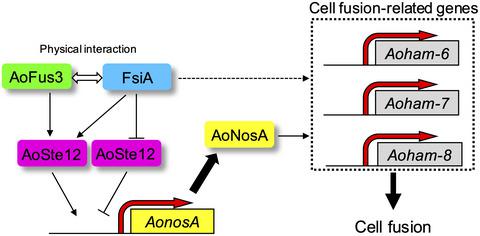当前位置:
X-MOL 学术
›
Mol. Microbiol.
›
论文详情
Our official English website, www.x-mol.net, welcomes your
feedback! (Note: you will need to create a separate account there.)
Novel Fus3‐ and Ste12‐interacting protein FsiA activates cell fusion‐related genes in both Ste12‐dependent and ‐independent manners in Ascomycete filamentous fungi
Molecular Microbiology ( IF 2.6 ) Pub Date : 2020-11-06 , DOI: 10.1111/mmi.14639 Takuya Katayama 1, 2 , Özgür Bayram 3 , Taoning Mo 1 , Betim Karahoda 3 , Oliver Valerius 4 , Daigo Takemoto 5 , Gerhard H Braus 4 , Katsuhiko Kitamoto 6 , Jun-Ichi Maruyama 1, 2
Molecular Microbiology ( IF 2.6 ) Pub Date : 2020-11-06 , DOI: 10.1111/mmi.14639 Takuya Katayama 1, 2 , Özgür Bayram 3 , Taoning Mo 1 , Betim Karahoda 3 , Oliver Valerius 4 , Daigo Takemoto 5 , Gerhard H Braus 4 , Katsuhiko Kitamoto 6 , Jun-Ichi Maruyama 1, 2
Affiliation

|
Filamentous fungal cells, unlike yeasts, fuse during vegetative growth. The orthologs of mitogen‐activated protein (MAP) kinase Fus3 and transcription factor Ste12 are commonly involved in the regulation of cell fusion. However, the specific regulatory mechanisms underlying cell fusion in filamentous fungi have not been revealed. In the present study, we identified the novel protein FsiA as an AoFus3‐ and AoSte12‐interacting protein in the filamentous fungus Aspergillus oryzae. The expression of AonosA and cell fusion‐related genes decreased upon fsiA deletion and increased with fsiA overexpression, indicating that FsiA is a positive regulator of cell fusion. In addition, the induction of cell fusion‐related genes by fsiA overexpression was also observed in the Aoste12 deletion mutant, indicating that FsiA can induce the cell fusion‐related genes in an AoSte12‐independent manner. Surprisingly, the fsiA and Aoste12 double deletion mutant exhibited higher cell fusion efficiency and increased mRNA levels of the cell fusion‐related genes as compared to the fsiA single deletion mutant, which revealed that AoSte12 represses the cell fusion‐related genes in the fsiA deletion mutant. Taken together, our data demonstrate that FsiA activates the cell fusion‐related genes by suppressing the negative function of AoSte12 as well as by an AoSte12‐independent mechanism.
中文翻译:

新型 Fus3 和 Ste12 相互作用蛋白 FsiA 在子囊菌丝状真菌中以 Ste12 依赖性和非依赖性方式激活细胞融合相关基因
与酵母不同,丝状真菌细胞在营养生长过程中融合。丝裂原活化蛋白 (MAP) 激酶 Fus3 和转录因子 Ste12 的直向同源物通常参与细胞融合的调节。然而,尚未揭示丝状真菌中细胞融合的具体调控机制。在本研究中,我们将新型蛋白质 FsiA 鉴定为丝状真菌米曲霉中的 AoFus3 和 AoSte12 相互作用蛋白。的表达AonosA和细胞融合相关的基因时降低FSIA缺失和增加FSIA过度表达,这表明FSIA是细胞融合的正调节。此外,细胞融合相关基因的诱导在Aoste12缺失突变体中也观察到fsiA过表达,表明 FsiA 可以以不依赖 AoSte12 的方式诱导细胞融合相关基因。令人惊讶地,FSIA和Aoste12双缺失突变体显示出较高的细胞融合的效率并且与增加的细胞融合相关的基因的mRNA水平FSIA单缺失突变体,其表明AoSte12压制在细胞融合相关的基因FSIA缺失突变体. 总之,我们的数据表明 FsiA 通过抑制 AoSte12 的负功能以及通过 AoSte12 独立机制激活细胞融合相关基因。
更新日期:2020-11-06
中文翻译:

新型 Fus3 和 Ste12 相互作用蛋白 FsiA 在子囊菌丝状真菌中以 Ste12 依赖性和非依赖性方式激活细胞融合相关基因
与酵母不同,丝状真菌细胞在营养生长过程中融合。丝裂原活化蛋白 (MAP) 激酶 Fus3 和转录因子 Ste12 的直向同源物通常参与细胞融合的调节。然而,尚未揭示丝状真菌中细胞融合的具体调控机制。在本研究中,我们将新型蛋白质 FsiA 鉴定为丝状真菌米曲霉中的 AoFus3 和 AoSte12 相互作用蛋白。的表达AonosA和细胞融合相关的基因时降低FSIA缺失和增加FSIA过度表达,这表明FSIA是细胞融合的正调节。此外,细胞融合相关基因的诱导在Aoste12缺失突变体中也观察到fsiA过表达,表明 FsiA 可以以不依赖 AoSte12 的方式诱导细胞融合相关基因。令人惊讶地,FSIA和Aoste12双缺失突变体显示出较高的细胞融合的效率并且与增加的细胞融合相关的基因的mRNA水平FSIA单缺失突变体,其表明AoSte12压制在细胞融合相关的基因FSIA缺失突变体. 总之,我们的数据表明 FsiA 通过抑制 AoSte12 的负功能以及通过 AoSte12 独立机制激活细胞融合相关基因。











































 京公网安备 11010802027423号
京公网安备 11010802027423号